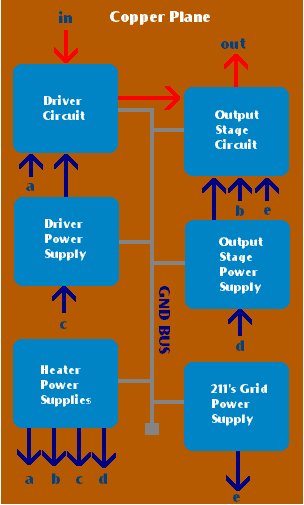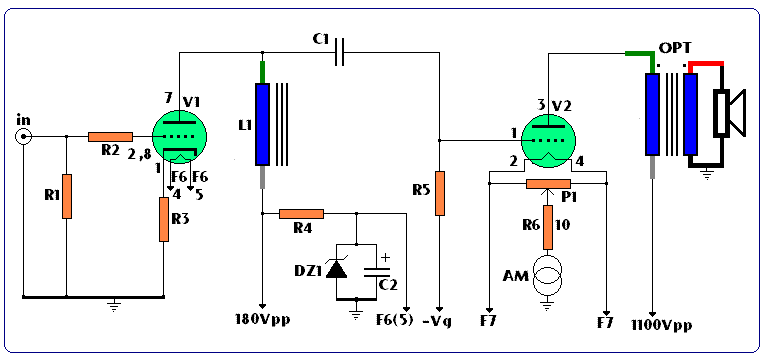|
|
6c45-211 Schematics
The 6c45-pe's performances are excellent! The (unique) voltage amplifier stage drives without problems the 211's grid pemitting also a "soft" A2-Class mode of operation. The 6c45-pe is a low power triode (8 watts max for the Pd paramenter.) with high-m, very high gm and low rp. It's cheap and readily available. Further, the equivalent noise resistance is 50ohm, making it well suited for a broad range of applications.

Fig. 1 The Block Diagram
Basically this amplifier is constitued by six sub-units, Fig. 1. The driver circuit (that included the 6c45 circuitry), the output stage circuit (with 211 circuitry) and four power supply unities respectively. Local GNDs are joined in a common ground bus solidal with an attentively evaluated point on the copper plane. The copper plane represents also the mechanical support for irons and power supplies capacitors. The signal paths has been kept very short. The Driver and the Output Stage, very close spacially, join a very small area close to the chassis front-end in order to maintain parasitcs fluxes as distant as possible.

Fig. 2 The Amplifier
Many ways exhist to realize a two stage SE amplifier. Based on my personal taste (derived both sonic and technical consideration), I have matured the following list:
a) 2 stage SE with Interstage Transformer;
b) 2 stage SE with LC Coupling;
c) 2 stage SE Loftin-White based;
d) 2 Stage SE with RC Coupling.
The solution with the Interstage Iron it's very difficult since the high cost requested to posses this kind of iron often is not supported by an adeguate electric response. The design of a good interstage transfomer is true White Magic Art!! So I have preferred the option b) relying in the convincement that tubes require magnetics as load for the best sonic response. The simplicity of this amplifier can be admired in Fig. 1. Take in mind that a two stage SE amplifier having a 211 (or similar) tube in the output is not an easy task! In fact as point-out in other section of this web, about the driver you can obtain the cumulative requirement of an high amplifiyng factor in union with good current capabilites with the special category of tubes maximizing the parameter s.
s = gm * m
There are so little triodes able to fullfill this requirement. The adopted choices are based on the use of EC8020, WE437A, CV5112/3A167M. Unfortunately this triodes are hard to find and uncheap. The introduction on the western market of the wonderful Russian triode 6C45-PE in the late '90 opened new ways. I found a first set of 45's in the 1996 thanks to an Hungarian channell and subsequently by the Russian dealer Navigator. Unfortunately in this latter years due to an increasingly worlwide request the price of the 6C45 boosted without (fortunately and for the moment) approaching that of previously mentioned triodes.
A key concept often negleted in similar design is that the major efforts are in the power supply side. Here I mean technical and economical efforts!
Fig. 3 The Power Supply (Click on it to enlarge)
In fact SE amps cannot produce a good sound without an attentively evalued and designed power supply. As the amplifying section you can consider a preferential list but there the choice is more simple because you has facet with:
a) Choke input filter power supply;
b) Capacitor input filter power supply.
Vacuum Diodes with no form of electronic regulation often produce better results. Taking a look on Fig.3, you observe a DC regulation for the 211' cathode (with the only IC regulator of the overall amplifier). The monitor is a simple circuitry able to temporize power supply events (more details on the simultion section).
Fig. 3 The Monitor (Click on it to enlarge)
|
What did you
think of this article? |